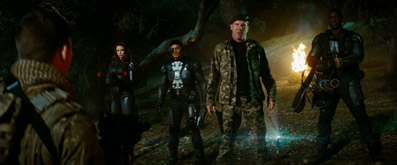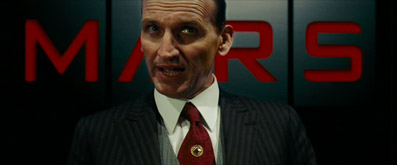"Bloody 'ell – they've built a military base underneath the polar ice caps." |
Cockney G.I. Joe soldier 'Heavy Duty' gives a
tactical appraisal of an impending battle |
A good short-hand way of describing a film to someone who has yet to see it is to think of where you might find it in the television schedules. Where Eagles Dare? Boxing Day, about 3pm, BBC2. Paranormal Activity? Channel 4, Wednesday night, 10:30pm. Shooter? Channel 5, midnight on a Friday. Whilst watching G.I. Joe – The Rise of Cobra, its impossible not to imagine yourself viewing in your living room on a Sunday at about 5:30pm, on ITV after You've Been Framed. Other films that would work in this slot could be Batman Forever, The Avengers and Independence Day: big, extravagant blockbusters that'll quieten the kids down after tea and help you forget about the impending return to work.
If this seems a bit reductionist, cordoning G.I. Joe into some kind of escapist play-pen while we all think about more artful features, then that is not the case at all. G.I. Joe is in fact one of the most enjoyable films that have been produced in a long time; riotously fun, spirited, good-natured and the first entry into what I hope will be a long running franchise. Its origins lie in a line of toys, comic books and cartoons that were birthed in the 60s but achieved real cultural prominence in the 1980s. The fictional universe featured the exploits of the Joes and their eternal battle against the terrorist organization Cobra, whose rise is documented here. Christopher Eccleston plays James McCullen, a weapons dealer who plans to use nanotechnology to simultaneously destroy entire cities and take over the world with an army of enhanced super-soldiers. The plot sees the Joes trying to stop the missiles before they hit the main capitals of the world (interestingly, Beijing has been added to the established pair of Moscow and Washington on the megalomaniac's hit list). Around this threadbare narrative the film hangs several action spectacles, in addition to a deal of character establishment and preparatory groundwork for later instalments of the franchise.

If the plot is unremarkable that is no reflection on the tone, character, design, style and narrative of the film which are anything but. G.I. Joe is deliriously operatic, melodramatic adventure that is a welcome antidote to the recent trend for the majority of action films to be incredibly earthy and gritty. In five years time G.I. Joe will be looked upon as something of a camp classic, but that is not to its detriment, and it does not mean the film should be dismissed. Camp is deceptively tricky to get right. Too often critics will praise something as camp to describe a film they like despite thinking they probably shouldn't; too often, film-makers use camp in order to deal with subject material they feel is beneath them. Here the correct tone is struck perfectly.
The key is that the performers play everything completely straight; there is none of the winking or elbow-nudging that actors in adventure films often love to engage in. The performers are earnest and honest for the most part, the heightened feeling comes from the writing itself. The relationships between the characters are full of overwrought intrigue, and the characterization itself is painted with a thick brush. My particular favourite on the Joe's side is Scarlett, who we're told graduated from Harvard at the age of twelve, reads books on astrophysics whilst on the treadmill and responds to a co-worker's clumsy flirtation with 'Attraction is an emotion. Emotions are not based on science. And if you can't quantify or prove that something exists, well, then in my mind, it doesn't.' This isn't so much on the nose as breaking it – but the film enjoys every clunky step of its heavy footing. Ripcord (Marlon Wayans) and Duke (Channing Tatum in a performance of the most pristine mahogany) are the newest recruits to the G.I. Joe team, and the early part of the film details their enlistment and training into the unit. Duke is the standard square-jawed blue-eyed Americana hero, and his perfection is grating. Ripcord wants to be a fighter pilot, which we're told early in the film in order that he can commandeer a top of the range jet fighter at the climax: again this is clunky, but enjoyably so in its brazenness. On the Cobra team there is the leather-clad Baroness (Sienna Miller), who it's revealed early on has a serious romantic relationship with Duke that ended badly. Each squad has a ninja: Snake Eyes is with the Joes, Storm Shadow with Cobra. They were rivals at the same martial arts school, and Snake Eyes has a vendetta against Storm Shadow after the latter murdered the school's Sensei. Antagonist James McCullen is descended from a line of Scottish arms dealers, and likes to talk a lot about clan history, in addition to saying things like 'you've really tossed the caber out of the park on this one!' Rounding out the Cobra team is the sinister Doctor (Joseph Gordon-Levitt), whose back story is revealed at the end of the film in a moment that is perfect in its absurdity. The characters are broad, their histories are ridiculously melodramatic, and the fact that enemy combatants on opposing sides all seem to know each other is ludicrous. But the film actively celebrates this with exaggerated dialogue and straight-faced performances, and the final effect is one of real charm.

It's in the design terms that G.I. Joe's glossy, polished look really comes to the fore. The fact that so much of the film is shot in specially constructed sets: underground lairs, secret laboratories, missile silos etc. lends it a certain retro feel, in an age where green screen art is fast replacing traditional set design. Despite some moments where green screen has been employed (the commentary mentions all of these, as well as some moments where sets were extended digitally), there are plenty of moments where the masterful set design can be well appreciated. They are wonderfully dressed and stylishly lit, and colour co-ordination is kept tightly controlled to give a degree of artifice that only ups the showy atmosphere. G.I. Joe is remarkably pretty to look at in certain places – one striking scene in The Baroness' mansion looks like it has been dipped in gold, such is the warmth and richness of the light and colour used. The costumes are the fairly generic black kevlar that most modern superheroes have adopted in place of lycra, but the designs of the weapons and vehicles is very well handled: no doubt with an eye on the inevitable tie-in toy line. Unfortunately, the quality of the CGI does not hold up everywhere, and for the large scale underwater set piece the visuals descend into video game territory. That said, the overall style of the film is highly effective.
There are a few problems with the film however. For starters, this is a shockingly violent piece. Heads get blown off, people get impaled, and we see a corpse's face melt away at one point: which is certainly at odds with the light, adventurous ambience the filmmakers have tried to create. All of the killing is mildly explained away by having the villainous 'Viper' soldiers being genetically modified, emotionless zombies, but this is a moot point. Our heroes shouldn't be relishing killing as much as they do here. At one point, Scarlett says to Ripcord: "if you're going to shoot something, kill it. Otherwise you might as well take up knitting," which is unsettling considering how the rest of the film is played almost as comedy. Secondly, the ending is hugely anti-climactic: introducing two brand new, important characters and then have them talk a little bit before the film ends abruptly. With the recent announcement of a sequel in pre-production it makes sense to get all of the foundations of the franchise laid in the one film, but still it feels hurried
If there is any doubt that G.I. Joe is intentionally bombastic, we need only look at a small scene set in East Africa, which acts as a flashback remembered by Duke. He and his American marine counterparts are running through desert streets, pinned down by gunfire, bombs whizzing overhead. The camera is fraught, hand-held: jerking and jittering with every blast, rarely cutting away, all close-ups and amplified sounds. This scene is shot entirely differently to anything else in the movie, so why? Possibly, to demonstrate that the decision to go glossy has been made deliberately: the rest of the film has Stephen Sommers' camera rushing forward to key objects in the scene like a child pushing through a crowd on bonfire night, all very controlled, simple, and action-orientated. G. I. Joe is uncynical, slightly saccharine, entirely unpredictable in its excesses; unafraid to engage in the highest kitsch. It is joyous, saccharine and ridiculous. Bollocks to irony: I loved it.
A clean and crisp anamorphic 2.40:1 transfer, much as you'd expect from a big budget modern American action movie, though not as skin-slicingly sharp as the Transformer: Revenge of the Fallen transfer. This is actually a good thing, as the picture here has a more filmic look and feels less obviously digital, although the CG effects shots do look exactly like CG effects shots. As ever, some wild post-production colour timing makes it hard to judge whether the colour reproduction is true to the original, but it seems fine. Doubtless the Blu-ray looks very impressive.

The Dolby surround 5.1 soundtrack is no where near as aggressive as you'd expect, even on spectacular crashes, with LFE bass in particular used with the sort of restraint a film like this could happily dispense with. No issues with clarity or dynamic range, of course, and the full sound tage is employed for music, effects and even dialogue. There are four spoken language tracks, an English audio descriptive track and a dizzying nineteen subtitle options.
Feature Commentary is provided here by Stephen Sommers and Bob Duscay (producer and editor). Good back and forth, addressing the problems of translation from franchise to screen among other things. Very effects-focused, not too much on the actors either but a good listen none the less. Sommers in particular comes across as a lovely chap.
The Big Bang Theory: The Making of G.I. Joe (29.34)
Pretty standard EPK making-of, featuring cast talking heads talking about how wonderful the set was, how great it was to work with the crew etc. There is some good material on the production design and stunts, and the appearance of a Hasbro exec (the same bloke from the Transformers: Revenge of the Fallen disc) talking about brand exploitation is also of note.
Next-Gen Action: The Amazing Visual FX and Design of G.I. Joe (21.08)
Scene breakdown of several key sequences, showing where the CGI effects were added in. Good stuff on the digital extension of the sets, but as with a lot of effects features can get a little tech-y.
Old-skool in every way, this is pure entertainment at its finest. Enormously enjoyable, loud, audacious; G.I. Joe is excessive without being obnoxious, camp without the being smug and fun without being brainless. Opera with bullets.
|